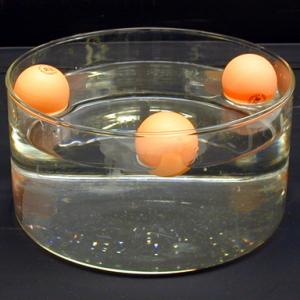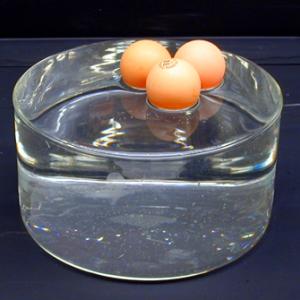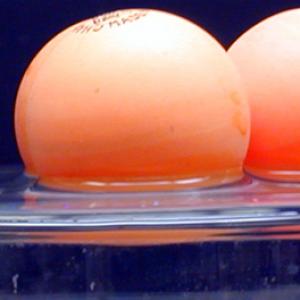College of Liberal Arts & Sciences
2A20.45 - Meniscus - Stable Equilibrium
Start with the evaporating dish and water. The water should come to about 1" from the top of the evaporating dish to start the experiment. Add 1 to 3 ping pong balls and notice that they will quickly migrate to the sides of the dish (Concave meniscus). Adding more water to the evaporating dish until the dish is overfull will cause the ping pong balls to migrate to the center of the dish (Convex meniscus).
- Mohamed Boutinguiza Larosi, "Floating Together on the Top", TPT, Vol. 53, # 2, Feb. 2015, p. 93.
- Wojciech Dindorf, "Stable Equilibrium at the Top of a Hill", TPT, Vol. 40, # 2, p. 116, Feb. 2002.
- Harold J. Teague, "Position of Objects Floating in a Glass", TPT, Vol. 36, # 7, p. 410, Oct. 1998.
- Martin Gardner, "Two Corking Good Challenges", TPT, Vol. 31, # 8, Nov. 1993, p. 477.
- George B. Barne, "Divergent Barroom Physics", TPT, Vol. 14, # 1, January 1976, p. 41.
- James T. Schreiber, "Barroom Physics, Part II", TPT, Vol. 13, # 7, Oct. 1975, p. 418.
- Richard A. Marble, "Floating Objects", TPT, Vol. 10, # 2, Feb. 1972, p. 67.
- James T. Schreiber, "Barroom Physics, Part 1". A Potpourri of Physics Teaching Ideas - Fluids and Heat, p. 125.
- Martin Gardner, "Two Corking Good Challenges", Science Tricks, p. 13.
- Martin Gardner, "Center the Cork", Entertaining Science Experiments with Everyday Objects, p. 117.
- Vicki Cobb and Kathy Darling, "Floating Odds", Bet You Can't!, p. 62.
- Yves Pomeau and Emmanuel Villermaux, "Two Hundred Years of Capillarity Research", Physics Today, March 2006, p. 39.
- Jearl Walker, "2.85, Breakfast Cereal Pulling Together", The Flying Circus of Physics Ed. 2, p. 119.
Disclaimer: These demonstrations are provided only for illustrative use by persons affiliated with The University of Iowa and only under the direction of a trained instructor or physicist. The University of Iowa is not responsible for demonstrations performed by those using their own equipment or who choose to use this reference material for their own purpose. The demonstrations included here are within the public domain and can be found in materials contained in libraries, bookstores, and through electronic sources. Performing all or any portion of any of these demonstrations, with or without revisions not depicted here entails inherent risks. These risks include, without limitation, bodily injury (and possibly death), including risks to health that may be temporary or permanent and that may exacerbate a pre-existing medical condition; and property loss or damage. Anyone performing any part of these demonstrations, even with revisions, knowingly and voluntarily assumes all risks associated with them.


